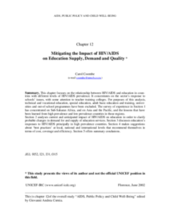The twelfth chapter of the study entitled AIDS, Public Policy and Child Well-Being, this paper focuses on the relationship between HIV/AIDS and education in countries with different levels of HIV/AIDS prevalence. It concentrates on the sector’s response to schools’ issues, with some attention to teacher training colleges. For purposes of this analysis, technical and vocational education, special education, adult basic education and training, universities and out-of-school programmes have been excluded. The survey of experience has concentrated on Sub-Saharan Africa, and on Asia and the Pacific, and the lessons that have been learned from high prevalence and low prevalence countries in those regions.
Section 2 analyses current and anticipated impact of HIV/AIDS on education in order to clarify probable changes in demand for and supply of education services. Section 3 discusses education’s responses to HIV/AIDS principally in high prevalence countries. Section 4 makes suggestions about ‘best practices’ at local, national and international levels that recommend themselves in terms of cost, coverage and efficiency. Section 5 offers summary conclusions.
©UNICEF

